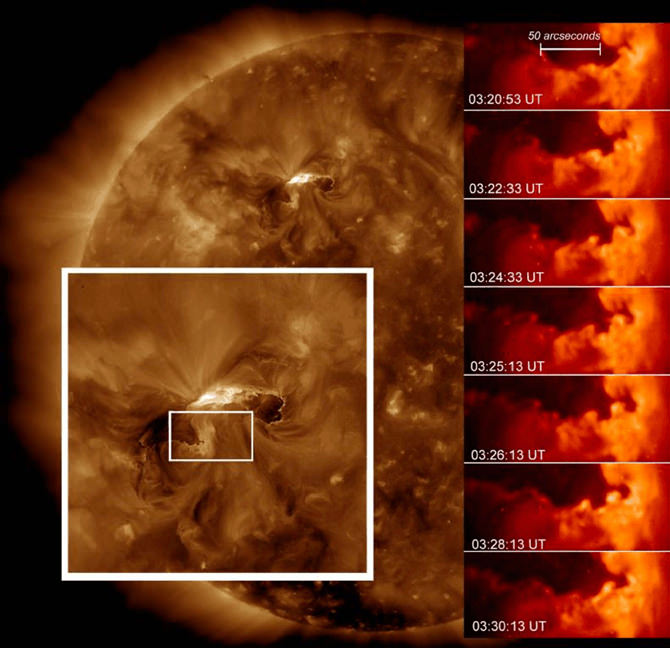[/caption]
Surf’s up on the Sun! Our favorite gnarly spacecraft, the Solar Dynamics Observatory (SDO) has caught conclusive evidence of classic “surfer waves” in the Sun’s atmosphere. But these waves trump ‘Hawaii Five-O’ surfing big time, as they are about the same size as the continental U.S. Spotting these waves will help our understanding of how energy moves through the solar atmosphere, known as the corona and maybe even help solar physicists be able to predict events like Coronal Mass Ejections.
Just like a surfing wave on Earth, the solar counterpart is formed by the same fluid mechanics — in this case it is a phenomenon known as a Kelvin-Helmholtz instability. Since scientists know how these kinds of waves disperse energy in water, they can use this information to better understand the corona. This in turn, may help solve an enduring mystery of why the corona is thousands of times hotter than originally expected.
“One of the biggest questions about the solar corona is the heating mechanism,” says solar physicist Leon Ofman of NASA’s Goddard Space Flight Center, Greenbelt, Md. and Catholic University, Washington. “The corona is a thousand times hotter than the sun’s visible surface, but what heats it up is not well-understood. People have suggested that waves like this might cause turbulence which cause heating, but now we have direct evidence of Kelvin-Helmholtz waves.”
Even though these waves occur frequently in nature here on Earth, no one had seen them on the Sun. But that was before SDO.
Ofman and colleagues spotted these waves in images taken on April 8, 2010 in some of the first images caught on camera by SDO, which launched in Feburary last year and began capturing data on March 24, 2010. Ofman & team have just published a paper in Astrophysical Journal Letters.
Kelvin-Helmholtz instabilities occur when two fluids of different densities or speeds flow by each other. In the case of ocean waves, that’s the dense water and the lighter air. As they flow past each other, slight ripples can be quickly amplified into the giant waves loved by surfers. In the case of the solar atmosphere, which is made of a very hot and electrically charged gas called plasma, the two flows come from an expanse of plasma erupting off the sun’s surface as it passes by plasma that is not erupting. The difference in flow speeds and densities across this boundary sparks the instability that builds into the waves.
On the sun, the two fluids are both plasmas — expanses of super hot, charged gases — which interact. One is erupting from the surface and shooting past a second plasma that is not erupting. The resulting turbulence is a Kelvin-Helmholtz wave form.
The erupting plasma is likely from a Coronal Mass Ejection, such as was seen earlier this week, where the Sun violently propels massive amounts of high-speed plasma particles into space. So, knowing more about the how the corona is heated and what the conditions are just before the KH waves form might give scientists the ability to predict a the next CME, which is a long-standing goal of solar scientists.
But figuring out the exact mechanism for heating the corona will likely keep solar physicists busy for quite some time. However, SDO’s ability to capture images of the entire sun every 12 seconds with such precise detail will certainly provide the data needed.
Source: NASA
You can follow Universe Today senior editor Nancy Atkinson on Twitter: @Nancy_A. Follow Universe Today for the latest space and astronomy news on Twitter @universetoday and on Facebook.


Just a “warm up” for its role in the cataclysm coming in 2012. LOL
Just a “warm up” for its role in the cataclysm coming in 2012. LOL